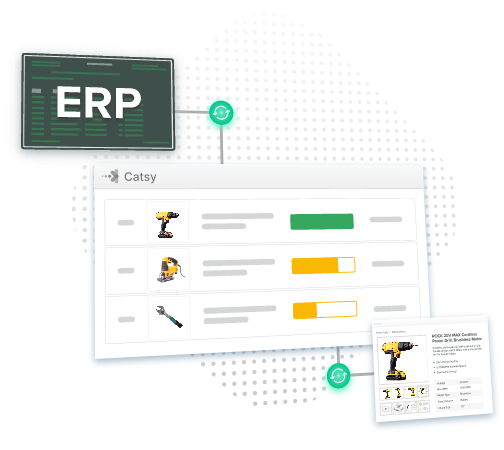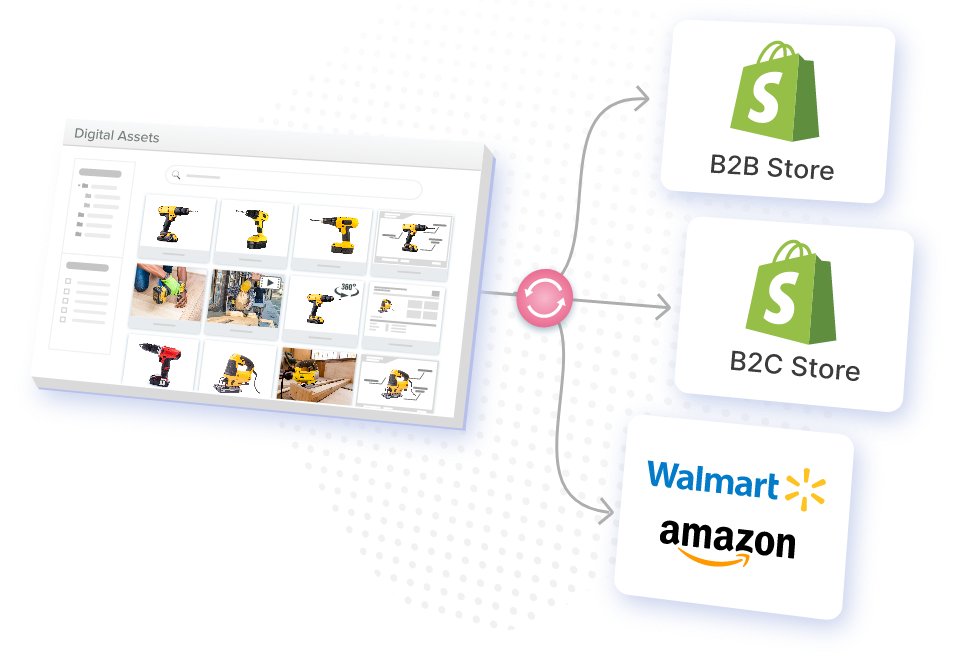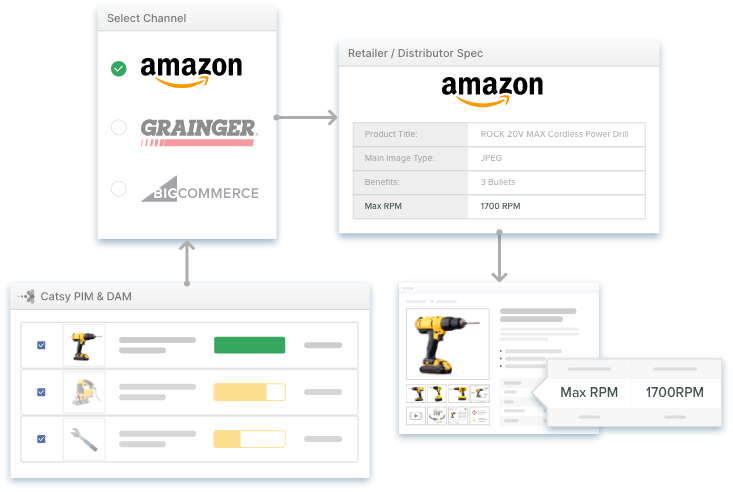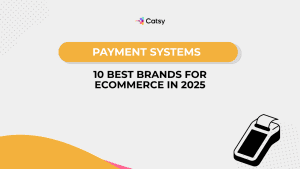B2B Product Marketers: 7 Tips to Elevate Your Marketing Strategy in 2024

In this Article
In contrast to new years resolutions many people make, with goals to weigh less and spend less, companies primarily have one goal: sell more. To experience B2B eCommerce growth 2024, marketers must have a unique strategy to capture the attention of casual browsers and turn them into loyal customers.
As market demands increase, new trends are emerging. B2B product marketers who want to expand must be familiar with the trends and meticulously implement them. When it comes to eCommerce, optimizing product content is a surefire way to find success. In fact, 57% of B2B marketers say that eCommerce SEO generates more leads than any other marketing initiative.
From solidifying your technology stack to securing digital assets for back-end of operation sharing, this article explores seven tips to elevate your marketing strategy in 2024.

1. Solidify your technology stack with multi-function software solutions.
Software automation tools, whether functioning as marketing automation tools or product data optimization, are essential for growing your brand at scale. 53% of B2B organizations already implement marketing automation, and 37% plan to implement it.
Of course, manually completing all tasks involved with marketing a product is always an option. However, 77% of marketers who use marketing automation tools have reported increased conversions. If you want to improve your marketing campaign effectiveness, automation could be a game changer for you.
Finding the right tools to fit in with your workflow processes can be challenging. Several tips to keep in mind when browsing for multi-function software solutions:
- Ensure the software can integrate with your existing solutions, such as your ERP system.
- If you don’t want to hire an IT team, make sure the system is SaaS and cloud-based.
- Schedule a demo with the sales team to ensure all of your needs will be met.
When it comes to a multi-function software solution for scaled marketing growth, having a centralized product information management and digital asset management can save your team countless hours of time while improving speed to market for your products. Let’s discuss several benefits of including a centralized PIM and DAM systems in your technology stack.
1. Making the switch to a centralized PIM and DAM solution.
As a product marketer, having all your product information on a centralized platform is an essential strategy to your business’s success.
For example, suppose you have extensive product catalogs and complex pricing. In that case, managing all the assets associated with these products without any error is almost impossible. Each product has its specific, important information, and you have to be consistent across all your marketing channels. This is where a PIM and DAM solution comes in.
Product information management software (PIM) allows you to manage all your product information: from stock levels to pricing to descriptions pertaining to certain SKUs. Furthermore, you can collect all this data in one source and distribute it across various channels.
In a similar vein, digital asset management (DAM) is where you will store all your product’s digital assets such as photos, videos, PDFs, etc. DAM enables you to consolidate these digital assets in a single source of truth and organize them based on each product specification.
A complete PIM software with DAM solution, can be a compelling force that to propel your marketing efforts. DAM improves product categorization in PIM, ensuring the storage and find-ability of assets. You can quickly assign product tags to images, videos, or any asset. In addition, a built in workflow streamlines team members’ communication and increases your product’s time-to-market speed.
In other words, a PIM and DAM solution is crucial to your marketing strategy in 2024. As the marketplace continues to get crowded, building a system that allows you to plan, organize, implement, and distribute is essential to stand out.
2. Integrating your ERP system with PIM and DAM.
A good guess is that you are already using Enterprise Resource Planning (ERP). But have you leveraged the power of integrating your ERP system with PIM and DAM?

While ERP already helps you manage your day-to-day business activities, integrating it with PIM and DAM enables you to establish a strong foundation for your marketing strategy. Think of it as a central system that aligns business processes, product information, and digital assets. This means you can access accurate, real-time data while consolidating all other aspects of your business.
Without an integration between systems, you’ll have to rely on manual entry. Not only is manually entering data extremely time consuming, but can result in a host of errors in critical product data.
Integrating these three systems can help you achieve B2B eCommerce growth 2024. You will deliver accurate product pages to improve customer experience and increase conversions.

2. Re-think visual commerce for increased product page engagement.
Prioritizing visual commerce cannot only make your product pages more inviting, but it can boost product page engagement. In fact, 67% of consumers have said that top-quality visual content influences them more than product descriptions or customer ratings. This is understandable because people are wired to value images. As a result, they are more likely to remember visual content than any other form of content.
Undoubtedly, visual commerce is important to include in your marketing plans for 2024. As more B2B buyers will be shopping online for their products than ever, visual commerce will be essential for converting customers
Savvy product marketers are leveraging visual commerce to interact with their customers. By strategically integrating visual content, you present the value of your product directly to the customer. This will improve brand loyalty and increase your product page engagement, leading to more conversions.
Providing visual aids to product pages allows browsers to quickly assess if your product fits their needs. Also, the more digital assets you have, the more likely visitors will stay on your site, decreasing your average page bounce rate.
Prioritize 360-degree images.
Strategic landing pages are used by 68% of B2B businesses to acquire leads. One way to enhance product pages is with 360 degree images. High engagement content such as 360 degree images is an impressive way to keep viewers engaged on your product pages.
Especially for new product introductions, where even repeat buyers have never experienced the product, 360 degree images provide the buyer with a lot of information in a little bit of time.
So, what difference will videos make for you in 2024?
A 2018 survey revealed that 54% of consumers wanted more engaging content from brands they like. This explains why 52% of marketing professionals believe bring the highest ROI.
While a picture is worth a thousand words, videos seem to be worth more. 360 videos have been on the rise in the last four years. In the first ten months of 2017, 360 videos on Facebook and YouTube had 4.5 billion views combined. However, despite this unprecedented rise of 360 videos, only a handful of marketers have taken advantage of it.
The fact is that more customers want more and more visual content and won’t change in 2022. Videos can make your product pages more powerful and help scale your product marketing efforts in the new year. And when customers can’t find the product information they are looking for, about 70% leave the page.
Videos for B2B eCommerce Growth 2024
Several surveys have shown that customers are more confident about a product that shows the quality, real-life features of a product through a video. It makes them trust the brand and influences their decision-making.
A video also allows your customers to have a closer look at the product, displaying all possible angles. For customers, this gives them a feeling of them inspecting the product. Something they are used to when buying a physical product. In addition to that, you will significantly reduce the number of product returns, which saves you money and time.
User-generated content
Something to keep in mind while forming your marketing strategy: user-generated content. For example, 31% of consumers consider user-generated content an essential element of an advertisement. Similarly, 42% of marketers say that implementing user generated content is vital to their marketing strategy.
Today, top brands rely on user-generated content to boost their lead generation efforts. Customers trust other customers. According to Adweek, 85% of users are influenced by user-generated content more than the content created by brands themselves. This is why you have to rethink how you use your user-generated content.
While user generated content itself is meant to keep visitors engaged, it also contains an underlying benefit for your brand. As users browse your b2b eCommerce website and see products that are relevant to them over and over again, they’ll be more convinced that your brand is capable of meeting their needs and more likely to make a purchase from your site.
B2B eCommerce Growth 2024
An essential benefit of user-generated content is that it provides audience insights. This will help you understand your ideal customer profile, assess what they like about your product, and apply the insights into promoting products in future marketing campaigns.
Personalized content can go a long way in your 2024 Marketing strategy.

3. Add Amazon and Walmart Marketplaces to your omni-channel lineup.
As a B2B marketers, your company may or may not be selling on B2C marketplaces. If you’re still attempting to nail down a strategy for B2B channels, you may wait to implement selling on Amazon and Walmart marketplaces. However, if you already have a smooth operating machine for existing channels, adding two more can be fairly easy, especially with the help of a best PIM software.
Selling in popular marketplaces such as Amazon and Walmart is a strategic move to consider to branch a B2B business into the B2C eCommerce space. These platforms offer various sales options with a robust and loyal audience.

1. Quickly get your products in front of a large audience.
Amazon has 200 million Amazon Prime members globally. In the United States alone, the platform has 214.43 million visitors monthly. Similarly, Walmart’s weekly customer visits globally are 240 million. These two have a large audience that can benefit your product.
2. Easily add channels with Catsy PIM
Using a product information management system can drastically cut down the time and preparation it takes to add a new channel to your omni-channel lineup. With Catsy PIM, you can tailor products to to Amazon and Walmart spec requirements, measure for completeness, and export in specific channel-ready format.
In addition, Catsy has a content grading system that lets you know if product information is complete and ready to publish. This makes sure you have accurate, consistent, and up-to-date product information on these platforms.
3. Optimize content for channels with channel templates
Each eCommerce platform has different requirements for product pages. This means you have to tailor your product details for each channel. Catsy PIM has a channel-ready format that allows you to apply channel appropriate specifications and information for the desired channel.
All you have to do is select a group of products, apply the channel formatted template and click export. And you are good to go. Your products will go live without worrying about manual entry.

4. Prioritize Faceted Search – this is a must.
How will your customers buy your products if they can’t find them?
How will customers buy your products if they can’t find them? Applying faceted search with metadata attributes can increase product find-ability on your own eCommerce website, such Shopify, BigCommerce and Magento.
Faceted search is a functionality that enables users to filter, organize and narrow down their search based on specific filters such as price, color, size, brand, etc. As a result, it helps customers find products quickly, improving the customer experience.
Here are two ways faceted search can help you in expand B2B eCommerce growth 2024.

1. Improve SEO
Faceted search aims to improve customers’ experience on your eCommerce or e-retailer platforms. It helps shoppers have personalized product pages and even search with long keywords relevant to what they are looking to buy.
With Catsy PIM you can add unlimited metadata tags to enhance SEO. Plus, you can easily create a hierarchical taxonomy system to fuel additionally fuel faceted search.
2. Enhance product fundability and increase conversions.
Customers don’t want to spend so much time finding a product. In fact, they will leave your page if they’re not finding what they’re looking for in a matter of seconds. So when you enhance faceted search, you elevate your customers’ experience—in addition, making the buying process straightforward increases conversions significantly.

5. Optimize your content and ecommerce store for mobile use.
The chances that your customers access your website from a mobile device continue to increase. In the United States, 45% of eCommerce sales come from mobile eCommerce accounts.
Millennials are the primary users of mobile devices for shopping. As more of them use mobile eCommerce to buy from B2B organizations, product marketers must prioritize a mobile-friendly experience.
Here are a few tips on optimizing your eCommerce for mobile-friendliness.
1. Website speed is a priority for B2B eCommerce Growth 2022
Slow websites are absolute turn-offs. The longer it takes for a mobile page to load, the higher the chances of a user bouncing off the page. This is why speed matters. Customers don’t have the time or patience to wait for pages to load; it must be lightning fast.
Ideally, your eCommerce site should load as quickly as 2 seconds. Anything above 3 seconds is considered slow. Don’t discount the difference a second can make.
First, make sure your content is relevant and readable to improve your website speed. An excellent place to start is to take the Google mobile-friendly test.
In addition to that, ensure that you optimize your images, use caching plugins, and implement AMP protocols.
2. Avoid Ads and Popups
Both are annoying. They overwhelm the user and make it difficult to focus on why they are on your site. Google equally ensures that customers don’t have to go through such an experience by cracking down on websites with intrusive ads and popups.
So you should avoid ads and popups and focus on the content your customer is looking for.
3. Make your site responsive and navigation user-friendly
Your eCommerce site is responsive on desktop; is it the same on mobile? Make sure your website’s design is responsive and mobile-friendly.
Also, navigation is an integral part of a mobile web experience. Therefore, the more accessible your pages are, the more likely users are encouraged to stay and explore.

6. Make selling your products easy for e-retailers.
E-retailers relationships are more important for B2B businesses than perhaps any other sales model. B2B e-retailers such as Grainger, Ferguson, Fastenal and more provide B2B companies opportunities to sell to a wider audience.
That being said, having a good relationship with your e-retailers will always work to the benefit of your company. In the long run, creating processes to make your job easier as well as the job of your e-retailer contact will pay off.

Catsy PIM’s channel-ready export templates can contribute to maintaining business relationships with e-retailers. The software enables you to quickly and seamlessly provide product information in the specific format they want.
For example, let’s say you’re selling power drills. Your contact – let’s call her Sara – at Grainger would like to have the product information and digital assets for your new line of power drills sent over to them for new product introduction campaign on their website. She’d like to see it by the end of the day.
Instead of compiling all of the information on to a spreadsheet and creating a new dropbox folder specifically for sharing with Sara, Catsy allows you to select specific products (your entire new line) and apply a Grainger template to the existing product information.
That way, you can send only the product information your contact at Grainger really cares about, and you can do it in a matter of minutes. Additionally, Sara can quickly publish the new products to the Grainger website, saving her time and getting your products in front of potentially buyers sooner.
Whether you use Catsy PIM or another software solution, having a channel-ready export feature can increase revenue for your company, allowing you to experience B2B eCommerce growth 2024.

7. Secure digital assets for easy back-end operation sharing.
In addition to having a solution and forming a process for sharing product information, it’s important to consider a process for sharing digital assets as well. In fact, you may be accustomed to receiving requests for digital assets more regularly than product information.
A new way to share digital assets is through a dealer portal or branded portal, designed specifically for dealers and e-retailers to be able to securely access and take the assets they need, exactly when the need it.
A branded portal houses everything a dealer, retailer or even sales team member may need in order to sell your product effectively. This includes: digital catalogs, digital assets, PDFs and videos. Essentially, digital asset management is an extension of your digital asset management system.

The most crucial benefit of a brand portal is that they are self-serve, and you can control the access level for each user. This will improve your marketing strategies as you can now provide optimized digital assets on the go without worrying about losing your assets.
Digital asset management offers you a secure system to review, share and collaborate on assets sharing for product marketing campaigns.
B2B eCommerce Growth 2024 with Branded Portal
In addition to the ease-of-use self-serve portals provide for sales and outside partners, having a brand portal gives your B2B eCommerce company a step up for growth in the next year. An impressive extension of your brand, easy access to your digital assets can empower your partners and sales team members to represent your products in a powerful way.
Conclusion
B2B product marketers who want to scale their products conversions in 2024 must take these tips to heart. More and more businesses are using automation to streamline their workflow, improve productivity and deliver a better customer experience.
Increasing product page engagement in 2024 will not just be about persuasive product description; it will require having 360 degrees images and videos that allow buyers to see all features and angles of the product, giving them the feel of having a physical inspection. Also, you have to amplify user-generated content to increase product awareness and brand loyalty.
Take advantage of popular marketplaces like Amazon and Walmart. Their large audience will immensely benefit your marketing efforts. For better customer experience, prioritize faceted search and optimize content and eCommerce store for mobile use.
Catsy PIM and DAM feature impressive automated tools to help achieve your product marketing goals in 2024. Our channel-ready export templates allow you to improve your relationship with e-retailers. With our secure DAM software, you can share impressive brand portals that your partners can use easily to support your marketing efforts.
Learn more on how product information management software can fuel your marketing strategy in 2024 on our blog or check out our website to schedule a live demo.
B2B product marketers play a crucial role in understanding the target market, developing product positioning and messaging, creating effective marketing strategies, and driving successful product launches in the business-to-business (B2B) sector.
To identify the target market, B2B product marketers employ market research techniques, analyze industry trends, and segment the market based on factors such as industry, company size, geographic location, and buyer personas.
B2B product marketers can employ various strategies including content marketing, search engine optimization (SEO), social media marketing, email marketing, and strategic partnerships to generate leads and drive conversions.
Customer feedback is invaluable to B2B product marketers as it provides insights into customer satisfaction, product usage, and areas for improvement. By actively seeking and analyzing customer feedback, product marketers can make data-driven decisions, refine product positioning, and develop effective marketing campaigns.
B2B product marketers measure the success of their marketing efforts using key performance indicators (KPIs) such as lead conversion rates, customer acquisition cost (CAC), customer lifetime value (CLV), website traffic, engagement metrics, and sales revenue. Regular tracking and analysis of these metrics allow product marketers to optimize their strategies and achieve better results.




